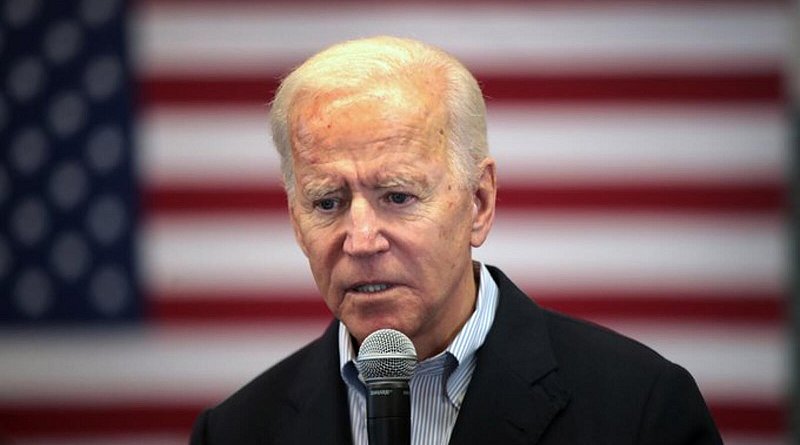Vice Presidential Pick A Key Test For Biden – OpEd
By Arab News
By Andrew Hammond*
The US presidential contest moves out of its coronavirus “deep freeze” on Friday with the result of the Hawaii Democratic primary. With Joe Biden already having the race wrapped up, the next key decision in the campaign is likely to come with his choice of vice presidential running mate.
A wide range of women candidates (Biden has said he will not select a man) are being touted in the media. They are of varying ages, ethnicities and experience as Biden searches for the strongest possible pick to provide momentum against President Donald Trump in what is already one of the strangest election years in US history because of the coronavirus pandemic. Three candidates who appear toward the top of his list right now are senators who competed against him for the Democratic nomination: Elizabeth Warren from Massachusetts, who is a darling of the liberal wing of the party, centrist Amy Klobuchar from Minnesota, and biracial Kamala Harris from California.
The vice presidential selection process is an election-year custom that attracts great prominence, partly because of key changes in US politics in recent decades. This includes the fact that the vice presidency has become perhaps the best transitional office to the presidency, as Biden himself may show in November.
Another factor is that the electoral stakes have grown — in the nuclear age — of selecting a deputy who is perceived to be capable of assuming office effectively upon the incumbent’s unanticipated death or incapacity. This is especially important for Biden as, if he is elected, he will become, at 78, the oldest person to assume the presidency.
History underlines the crucial role that vice presidents stepping up to the presidency have played, and it is perhaps Harry Truman who best exemplifies this. Within weeks of assuming office in 1945, Truman had to make several highly consequential, controversial decisions, including the dropping of atomic bombs on Hiroshima and Nagasaki.
In this context, Biden will try to make a choice that will not harm his prospects and that avoids the mistakes that others have made. Take the example of the 2008 election, when Republican nominee John McCain, then aged 71, made the decision to select Sarah Palin, whose only noteworthy experience of office was less than two years as Alaska governor. Rather than boosting McCain’s campaign, Palin was — ultimately — widely viewed as being too inexperienced to effectively be a heartbeat away from the presidency.
Historically, the process of selecting vice presidential nominees tended to be fashioned around issues like reconciling important party stakeholders after potentially bruising nomination contests or the perceived advantage of cultivating “balanced tickets,” in which the vice presidential and presidential candidates were differentiated by factors such as their “home” region, so as to maximize support across the nation.
Potential balanced ticket candidates for Biden — a former senator from Delaware — include several African American politicians: Former Georgia gubernatorial candidate Stacey Abrams, Florida Rep. Val Demings, former Obama administration National Security Adviser Susan Rice, and Atlanta Mayor Keisha Lance Bottoms. Others include Asian American Sen. Tammy Duckworth from Illinois and Latino Sen. Catherine Cortez-Masto from Nevada.
However, partly because of changes in the presidential nomination system, and indeed the proliferation of mass media, these traditional considerations — while still of enduring consequence — are less relevant to the modern process. For instance, Al Gore was selected in 1992 by Bill Clinton (a fellow centrist Democrat and southerner) not to balance the ticket but to reinforce the narrative about Clinton’s New Democrat candidacy.
Whether or not these developments have injected greater uncertainty into the vice presidential selection process, it is unquestionably the case that choices are routinely made that confound the pundits. For instance, few anticipated the selections in 2012 of former congressman Paul Ryan by Mitt Romney, in 2008 of Palin or Biden himself, or in 2000 of former Defense Secretary Dick Cheney (George W. Bush) and Joe Lieberman (Al Gore).
The selections of Washington veterans Cheney and Biden were noteworthy inasmuch as they were chosen, in significant part, to fortify the perceived political inexperience of Bush and Barack Obama, respectively. Like Biden, Cheney enjoyed extensive influence as vice president and the latter is viewed as the most powerful ever holder of the office.
The selections of Cheney and Biden were also interesting in another sense: Both Bush and Obama perceived that neither of their older running mates represented a political threat to them, so would be ultra-loyal. From the prism of the past few decades, this is unusual, and Biden may well select a candidate who is a generation younger and who could well be a future presidential candidate.
Since 1960, four former vice presidents (Richard Nixon in 1960, Hubert Humphrey in 1968, Walter Mondale in 1984, and Gore in 2000) won their respective party’s presidential nomination but then lost the election, while two ex-vice presidents have been elected president (Nixon in 1968 and George H. W. Bush in 1988). Biden hopes to be the third in November.
It is in this context of short-term political calculation and historical precedent that Biden will make what could prove to be the defining decision of his campaign. A miscalculation could be damaging but, if Biden’s selection wins strong approval, his candidacy may secure invaluable new momentum.
- Andrew Hammond is an Associate at LSE IDEAS at the London School of Economics

